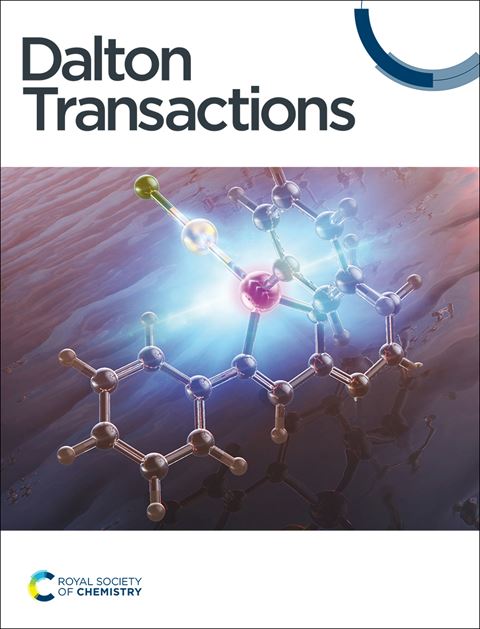具有取代 Hqnal 配体的自旋交叉 FeIII 配合物:阴离子和溶剂的影响
IF 3.5
3区 化学
Q2 CHEMISTRY, INORGANIC & NUCLEAR
引用次数: 0
摘要
一种新的取代 Hqnal 配体 Hqnal-5-Brq 和由此产生的四种 FeIII 复合物 [Fe(qnal-5-Brq)2]A-sol(A = NO3-,溶液 = CH3OH 1;A = ClO4-,溶液 = CH3OH 2;A=OTf-,溶液=2CH3OH-H2O 3;A=NTf2-,溶液=CH2Cl24;Hqnal-5-Brq=N-(5-溴-8-喹啉基)-2-羟基萘甲醛亚胺)。这四种复合物尽管阴离子不同,但都采用了类似的一维[Fe(qnal-5-Brq)2]+阳离子链,这些阳离子链通过正交的π---π相互作用连接在一起。这些链通过其他超分子相互作用进一步连接形成二维和三维结构。复合物 1-3 均表现出突变的自旋交叉行为,转变温度分别为 230、189 和 185 K,而复合物 4 则处于高自旋状态。通过对脱溶样品进行磁性测量,评估了溶剂对自旋交叉特性的影响。去溶胶后,复合物 1 和 2 的转变温度略有变化,而复合物 3 和 4 的磁性曲线则发生了显著变化。复合物 3 的去溶导致 HS 状态或非常不完全的滞后转变,不同批次样品的转变温度较低。相反,络合物 4 中的逐步解溶导致残留溶剂减少,并逐渐从稳定的 HS 状态过渡到 SCO 活性状态。本文章由计算机程序翻译,如有差异,请以英文原文为准。
Spin Crossover FeIII Complexes with a Substituted Hqnal Ligand: Effects of Anions and Solvents
A new substituted Hqnal ligand, Hqnal-5-Brq, and four resulting FeIII complexes [Fe(qnal-5-Brq)2]A·sol (A = NO3−, sol = CH3OH 1; A = ClO4−, sol = CH3OH 2; A = OTf−, sol = 2CH3OH·H2O 3; A = NTf2−, sol = CH2Cl24; Hqnal-5-Brq = N-(5-bromo-8-quinolinyl)-2-hydroxynaphthaldimine), have been synthesized and characterized. All four complexes, despite having different anions, adopt similar 1D [Fe(qnal-5-Brq)2]+ cation chains linked by orthogonal π···π interactions. These chains are further connected to form the 2D and 3D structures by other supramolecular interactions. Complexes 1-3 all exhibit abrupt spin crossover behaviors, with the transition temperatures being 230, 189, and 185 K, respectively, while complex 4 is in a high-spin state. The influence of solvents on spin crossover properties was assessed via magnetic measurements on the desolvated samples. Following desolvation, while complexes 1 and 2 show slight variations in their transition temperatures, complexes 3 and 4 undergo significant changes in their magnetic profiles. Desolvation in complex 3 leads to either a HS state or a very incomplete hysteretic transition with a low transition temperature for different sample batches. In contrast, the gradual desolvation in complex 4 leads to the diminished residue solvents and progressively transition from a stable HS state to an SCO-active state.
求助全文
通过发布文献求助,成功后即可免费获取论文全文。
去求助
来源期刊

Dalton Transactions
化学-无机化学与核化学
CiteScore
6.60
自引率
7.50%
发文量
1832
审稿时长
1.5 months
期刊介绍:
Dalton Transactions is a journal for all areas of inorganic chemistry, which encompasses the organometallic, bioinorganic and materials chemistry of the elements, with applications including synthesis, catalysis, energy conversion/storage, electrical devices and medicine. Dalton Transactions welcomes high-quality, original submissions in all of these areas and more, where the advancement of knowledge in inorganic chemistry is significant.
 求助内容:
求助内容: 应助结果提醒方式:
应助结果提醒方式:


